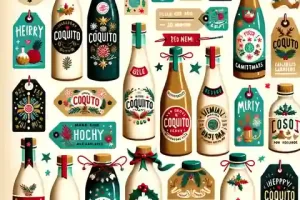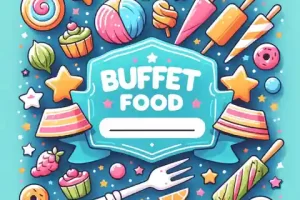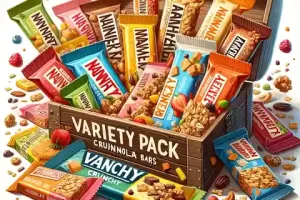Hey there! Let’s talk about organic food labels examples. These labels are super important for anyone who wants to eat healthy and natural foods.
Organic food labels are like helpful signs telling us about our food. They show if the food follows special organic rules, like the ones from the USDA in the United States.
For example, “100% Organic” means everything in the food is organic. “Made with Organic Ingredients” means most of it is organic.
It makes sure we pick food that doesn’t have bad stuff like certain bug killers, fake stuff, or GMOs (those are plants or animals changed in science labs). These foods are also grown in ways that are nice to the earth.
So, whether you’re buying fruits, veggies, milk, or snacks, looking for these organic labels is super important. Let’s learn more about them!
What Does “Organic” Mean?
The word “organic” is unique. It represents the food was produced in a good way for nature. It’s about farming food without using things that can harm the surroundings, like certain chemicals.
The USDA Organic Seal
When you see the “USDA Organic” seal on your food, it means that it has at least 95% organic stuff in it. This seal is a big deal because it tells you that the food meets strict rules set by the United States Department of Agriculture (USDA).
What is required to label food organic?
Some specific rules need to be followed. Here’s a simple explanation:
- Follow Organic Farming Methods: The food must be grown without using certain chemicals that can be harmful.
- USDA Certification: In the United States, the food needs to be certified by the USDA (United States Department of Agriculture). This means it meets their strict standards for being organic.
- 95% Organic Ingredients: To use the USDA Organic label, at least 95% of the ingredients in the food must be organic. The other 5% can be non-organic, but only if they are on a special list of approved items.
- No Artificial Preservatives or Flavors: Organic foods can’t have artificial preservatives, colors, or flavors. Everything needs to be natural.
- Special Handling: How the food is handled and processed is also essential. The equipment and process need to separate organic food from non-organic food.
- Regular Inspections: Farms and facilities that make organic food are checked regularly. This makes sure they keep following all the organic rules.
Remember, just because something says it’s “organic” doesn’t always mean it’s 100% organic. Always check the label to see how much of it is really organic.
Different Types of Organic Labels
- 100% Organic: This is the best! It means everything in the food, except water and salt, is organic.
- Organic: These products have 95–99% organic ingredients. The tiny bit that’s not organic is still checked to make sure it’s okay to use.
- Made With Organic Ingredients: These foods have 70–94% organic stuff in them. They can’t use the USDA seal, but they’ll tell you which ingredients are organic.
Why Choose Organic?
Choosing organic food is a really cool idea for many reasons! Here’s why opting for organic might be a good choice:
Benefits for the Environment
- Nature-Friendly Farming: Organic farming is all about being kind to nature. It doesn’t use the harsh chemicals that can hurt our planet, and it helps keep our water and land clean.
- Healthy Soil: Organic farming makes the soil really healthy because it doesn’t use bad chemicals.
- Saving Water: This type of farming often uses less water, which is great, especially where water is scarce.
Health Benefits
- Fewer Chemicals: Organic foods don’t have as many of those yucky pesticides that regular farming uses. This means it’s better for your health.
- Might Be More Nutritious: Some people think organic foods have more good stuff in them, like vitamins, because they don’t have artificial stuff or GMOs (that’s short for genetically modified organisms).
Helping Farmers and Animals
- Support Local Farms: When you buy organic, you’re often helping local farmers and small businesses.
- Happy Animals: Organic meat and dairy come from animals that get to live in nicer conditions and eat organic food.
Taste and Quality
- Better Flavor: Lots of people say organic fruits and veggies taste better. Maybe it’s because of the super healthy soil they grow in!
Community and Education
- Community Stuff: Organic farms love getting people involved and teaching them about farming that’s good for the Earth.
- More Plant Types: These farms grow lots of different plants, which is great for nature and helps keep pests away.
Choosing organic isn’t just about what you eat. It’s about taking care of our planet and everyone living on it.
Finding Organic Foods
Finding and understanding organic food labels is super important when you’re shopping. Here are some cool tips to help you out:
- Check Out the Labels: When you’re shopping, look for labels on fruits, veggies, snacks, or any food really. These labels are like little guides to help you pick the best stuff for you and for the Earth.
- Different Types of Labels: Remember, there are different kinds of organic labels like “100% organic,” “organic,” and “made with organic ingredients.” Each one means something a bit different.
Tips for Understanding What the Labels Mean
- Look for the USDA Seal: If you see the “USDA Organic” seal on a product, that’s a great sign! It means the food meets some really strict rules about being organic. This seal is like a green thumbs-up for organic food.
- Read the Ingredients List: It’s always good to check what’s actually in the food. The ingredients list tells you what’s inside. If most of the stuff listed is organic, you’re on the right track.
- Ask Questions at the Farmers’ Market: If you’re at a place like a farmers’ market, you can talk to the people who grow the food. Ask them how they farm their stuff. Farmers usually love to talk about their organic farming ways!
Remember
- Not All Organic Is the Same: Some foods might say “organic” but they might not be 100% organic. That’s why checking the label and ingredients is key.
- Local Doesn’t Always Mean Organic: Sometimes, local food isn’t organic. So, if you’re looking for organic, make sure to check.
By using these tips, you’ll become a pro at picking out the best organic foods. Next time you go shopping, keep an eye out for those labels and don’t be shy to ask questions about how the food was grown.
Organic food labels misleading
Organic food labels are supposed to help us choose healthy foods, but sometimes they can be a bit tricky. Here are 8 of the most common misleading food marketing claims:
- No Nitrites or Nitrates Added: Even if a food says this, it might still have these things in it. They can come from natural sources.
- Uncured: This label doesn’t mean the food hasn’t been cured. It just means they used natural stuff to cure it, which is like the usual way of curing.
- USDA Certified Organic: Foods with this label are mostly organic, but not always 100% organic. Some parts might not be organic.
- Non-GMO: This just means the food doesn’t have genetically modified stuff in it. It doesn’t always mean it’s organic.
- No Added Hormones: For some meats like chicken and pork, they don’t use hormones anyway. So, this label doesn’t make them different.
- No Antibiotics: All meat goes through a check to make sure there’s no medicine left in it. So, this label doesn’t always mean a lot.
- Natural, All Natural, or 100% Natural: These words aren’t always strict. So, a food can have these labels but still not be totally natural.
- No Toxic Pesticides: Organic farming uses some types of bug spray, but they are the kinds that are okay for organic food.
It’s good to look at what’s in the food, not just the labels. This helps you really know what you’re eating. Remember, even if something says it’s organic or natural, check the rules to see if it really is.
Disadvantage of Organic Food Labels
When we talk about food with organic labels, it’s not always perfect. Here are some things that are not so great:
- Cost More Money: Organic foods often cost more because they take more work to grow. Also, farmers need to learn new ways to farm organically, which can be expensive.
- Hard to Find: Not everyone can afford organic foods because they are expensive. Plus, there are fewer organic farms, so it’s harder to find these foods in some places.
- Don’t Last Long: Organic foods don’t stay fresh as long as other foods. They don’t use things that make food last longer.
- Labels Can Be Confusing: There are different kinds of organic labels like “100% organic” or “made with organic ingredients.” This can be hard to understand.
- Might Have Germs: Without chemicals to kill bugs and germs, organic foods might have more of them. So, it’s really important to wash and cook them well.
- Can Be Unpredictable: Sometimes, the amount of organic food available can change a lot. This is because bugs or diseases might harm the plants more than on other farms.
- Not Always Better: Some people think organic food is always better and more natural. But this isn’t always true. Some organic foods are not much different from regular foods.
- Not Perfect for the Planet: Organic farming is often good for the environment, but not always. Sometimes, organic farming can use a lot of resources.
So, when you think about buying organic food, remember these things. It’s good to know both the good and not-so-good parts about organic foods.
Organic Food Labels Example
When you’re looking for organic food in the store, there are different kinds of labels you might see. Here’s a simple guide to what they mean:
100% Organic: This means everything in the product is organic. Like a bag of apples might say “100% Organic Apples.”
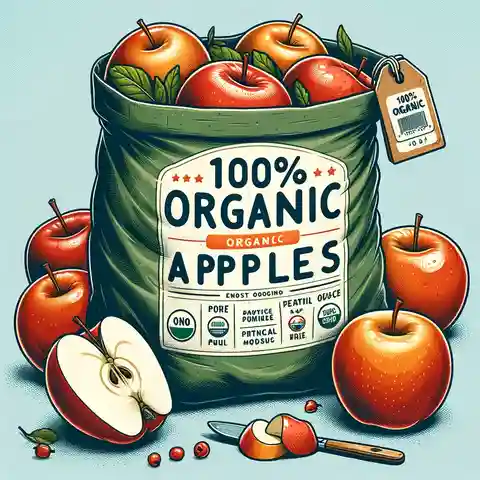
Organic: This label is for foods that are almost all organic. An egg carton might say “Organic Eggs” if 95% of it is organic.
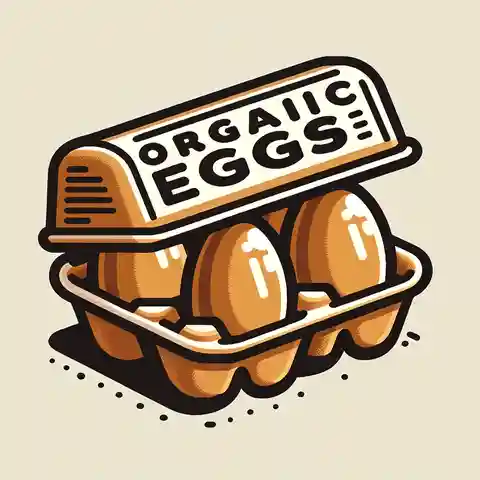
Made with Organic Ingredients: This is for foods that have a lot of organic stuff in them, but not all. Like a cereal box might say “Made with Organic Oats.”
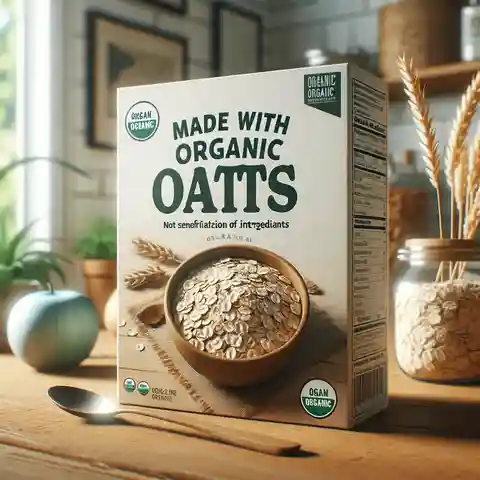
Specific Organic Ingredients: If a food isn’t mostly organic, they can still point out what parts are. Like a salad dressing might list “Organic Olive Oil” in its ingredients.
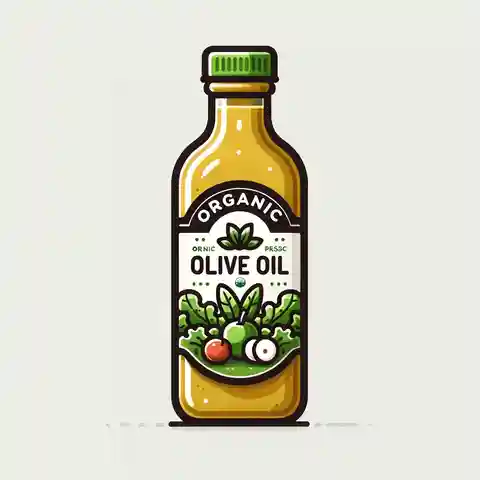
USDA Organic Seal: If you see this seal, it means the food meets special government standards for being organic. It’s on lots of different foods.
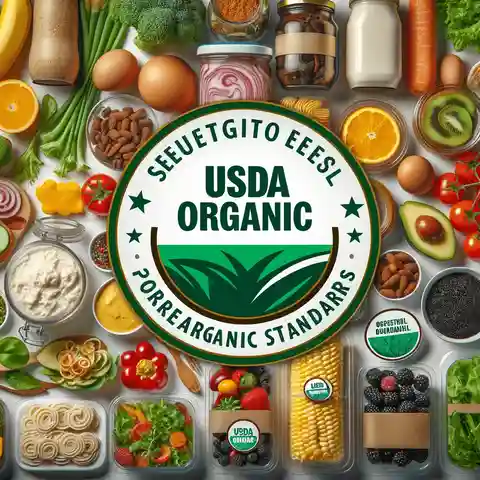
Non-GMO Verified: This label is on organic foods that don’t have any GMOs (those are genetically modified organisms).
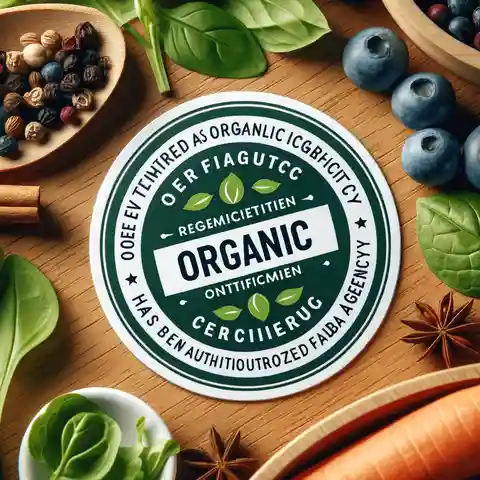
Grass-Fed Organic Dairy: This is used for dairy products like milk or cheese from animals that eat grass.
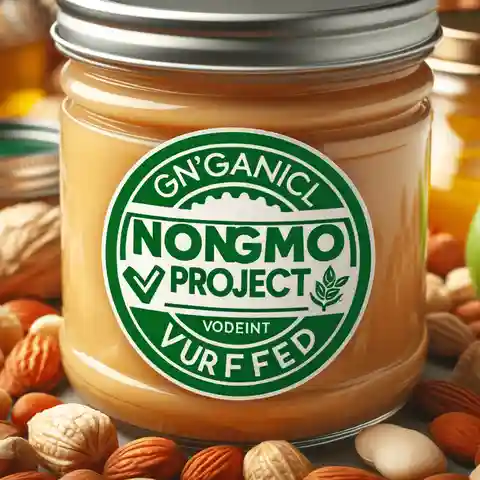
Organic Certification Agency: This label tells you who checked to make sure the food is really organic.
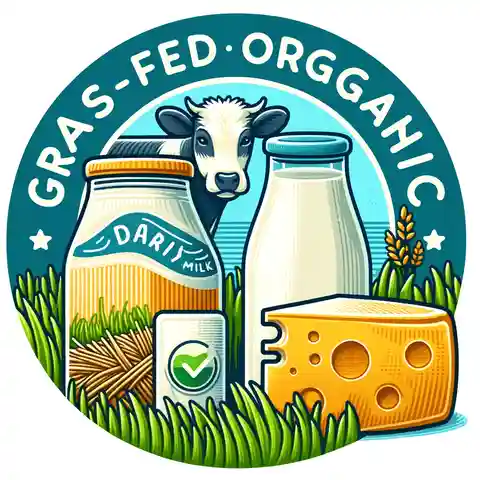
Organic Produce Stickers: Fresh fruits and veggies might have a sticker saying they’re organic. They usually have a code number that starts with 9.
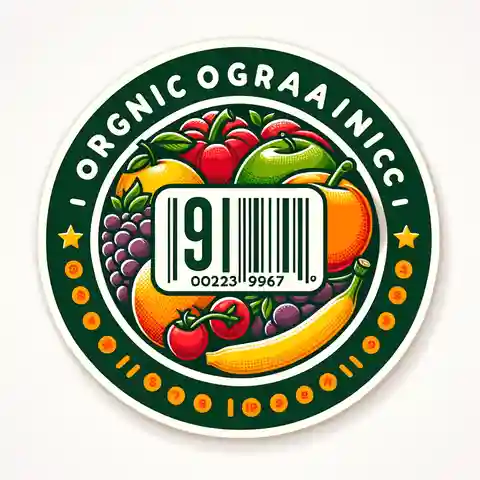
Organic and Fair Trade: Some foods, like coffee or chocolate, might be both organic and fair trade. This means they’re made in a way that’s good for the planet and the people who grow them.
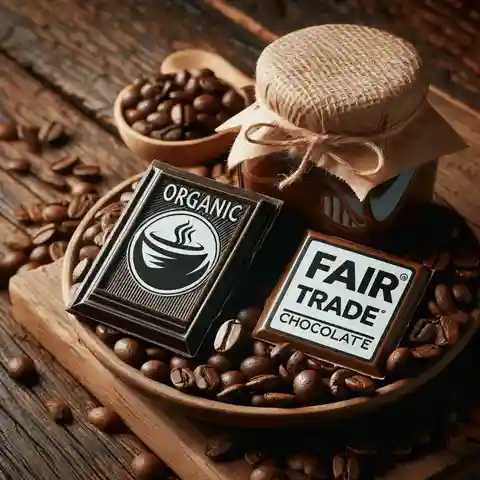
What is not allowed under an organic label?
Under organic labeling, there are specific things that are not allowed. Here’s a list of what you won’t find in products labeled as organic:
- Synthetic Pesticides and Fertilizers: Organic foods are grown without synthetic pesticides and fertilizers. This means chemicals commonly used to kill bugs or make plants grow faster are not allowed.
- Genetically Modified Organisms (GMOs): Organic products cannot contain GMOs. This means the food’s DNA hasn’t been changed in a lab to make it grow bigger or faster.
- Growth Hormones: Animals used for organic meat and milk don’t get special things to make them grow faster or make more milk.
- Antibiotics: Organic farming does not allow the use of antibiotics in animals. This is different from some non-organic farming, where antibiotics are used to prevent disease in animals.
- No Fake Colors or Flavors: Organic foods don’t have man-made stuff added to change their color or how they taste.
- Irradiation: This is a process that uses radiation to kill bacteria and other pathogens in food. It is not allowed for organic foods.
- Sewage Sludge as Fertilizer: Organic farming prohibits the use of sewage sludge, which is recycled human waste, as a fertilizer.
So, when you see “organic” on food, it means it was made without all these things. It’s a way to make sure the food stays really natural.
Labels on Beauty and Body Care Products
Not just food, but even things like shampoo and lip balm can have organic labels. But the rules are a bit different for these products. They have to be certified to special standards to use the “organic” label.
FAQs About Organic Food Labels
Do Organic Foods Stay Fresh Longer Than Other Foods?
Not really. Organic foods might go bad faster because they don’t have fake stuff to keep them fresh longer. It’s a good idea to eat them soon after you buy them.
Is “Natural” the Same as “Organic”?
Nope, “natural” isn’t the same as “organic.” “Organic” has special rules it needs to follow, but “natural” doesn’t mean it follows those rules.
Do Organic Foods Never Use Pesticides?
Well, not exactly. Organic foods can use natural bug sprays but not the man-made kind. The natural ones are safer than the ones used on other foods.
Can Meat and Milk Be Organic Too?
Yes! Meat and milk can be organic if the animals eat organic food and live outside without getting certain medicines or growth stuff.
If Organic Is Better, Why Doesn’t Everyone Farm This Way? Changing to organic farming can be hard and cost a lot of money. It also might not make as much food, so it’s a big decision for farmers.
Can Eating Organic Foods Cut Down on Chemicals?
Yes, eating organic foods means you’re around fewer bad chemicals. This is really good for moms-to-be, kids, and anyone who wants to stay healthy.
Organic food labels examples is not just about being healthy; it’s about caring for our Earth too. So, next time you see that organic label, you’ll know exactly what it means!
If you want to learn more, you can look up the rules from the USDA’s National Organic Program on their website.
FDA – https://www.fda.gov/food/food-labeling-nutrition/organic-food-labels
NSF, https://www.nsf.org/
The USDA Agricultural Marketing Service. https://www.ams.usda.gov/
